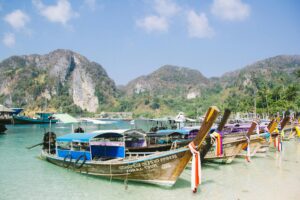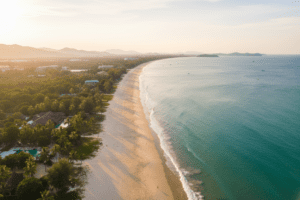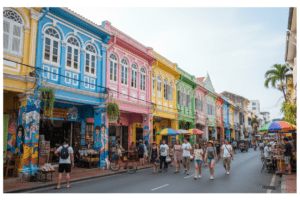Estimated reading time: 12 minutes
Key Takeaways
- The best time to visit Phuket weather-wise is November to April (dry season) for guaranteed sunshine and calm seas
- Peak season (December-February) offers perfect weather but comes with higher prices and crowds
- Rainy season (May-October) provides significant savings and fewer tourists, but expect afternoon showers and rough seas
- September and October are the wettest months with the highest risk of travel disruptions
- Temperature remains consistently warm year-round (24°C-36°C), so timing depends on rainfall and sea conditions
- Book accommodations 3-6 months in advance for dry season travel
- Sea conditions during rainy season can be dangerous – always heed red flag warnings
Table of Contents
- A Quick Guide to Phuket’s Tropical Monsoon Climate
- The Best Time to Visit Phuket Weather-Wise: November to April
- Everything You Need to Know for Phuket Dry Season Travel
- The Traveler’s Guide to the Phuket Rainy Season Months
- A Breakdown of Phuket Weather by Month
- Identifying the Worst Time to Visit Phuket
- Practical Tips for Planning Your Phuket Trip
- When Should You Actually Go?
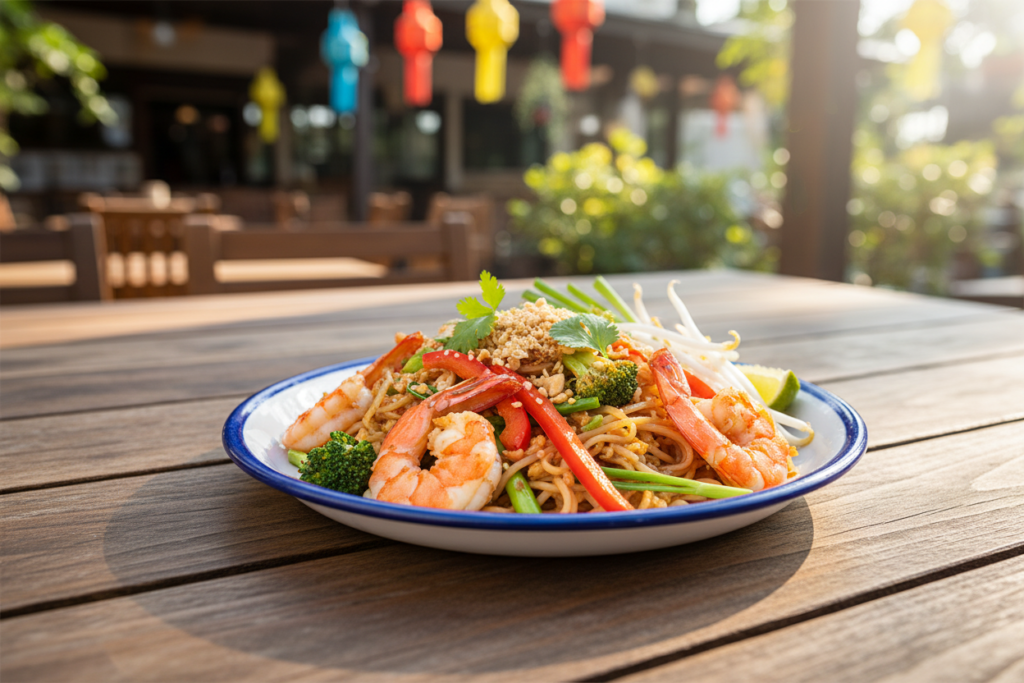
Figuring out when to visit Phuket is honestly the most important first step in planning the perfect tropical getaway. And here’s the thing—the answer isn’t the same for everyone.
It totally depends on whether you’re chasing those picture-perfect sunny days, trying to dodge massive crowds, or working with a tighter budget. Some people absolutely need guaranteed sunshine for their beach vacation, while others are perfectly happy trading a few rainy afternoons for significantly cheaper hotels and nearly empty beaches. If it’s your first time, check out our First Time Visiting Phuket? 2025 Visas, Beaches & Tips for essential pre-trip advice.
Phuket has what’s called a tropical monsoon climate, which basically means it operates on two very distinct seasons instead of the typical four you might be used to. There’s the dry season and the rainy season, and this seasonal shift is the key factor that’ll make or break your trip. Learn more about Phuket’s climate patterns on Hotels.com. Understanding these patterns is crucial because they affect everything from sea conditions to hotel prices.
You’re going to learn exactly what makes each season special—the best time to visit Phuket weather-wise, what to expect during the Phuket rainy season months, and a detailed breakdown of Phuket weather by month so you can plan like a pro.
A Quick Guide to Phuket’s Tropical Monsoon Climate
Let me break this down super simply. Phuket doesn’t do the whole spring-summer-fall-winter thing. Instead, it operates on a tropical monsoon climate with just two main seasons: the dry season (influenced by the northeast monsoon) and the rainy season (southwest monsoon).
The temperature? It’s warm year-round, typically bouncing between 24°C and 36°C (75°F – 97°F). Most days throughout the year, you’re looking at consistent highs around 31°C-32°C. So yeah, it’s always beach weather from a temperature standpoint.
But here’s where it gets interesting—humidity is always a factor, but it’s most comfortable during the dry season. It becomes pretty oppressive during the hot months of April and May, and then again during the wettest months of September and October when everything feels sticky and heavy.
The real game-changer? Sea conditions. During the dry season, you get those postcard-perfect turquoise waters that are calm, clear, and absolutely perfect for swimming and boat tours. But flip over to the rainy season (especially May through October), and you’re dealing with rough seas, big waves, and swimming conditions that can actually be dangerous. Check current sea conditions on Phuket Travel Secrets. Tour operators will literally cancel boat trips when conditions get too rough. For a climate comparison with neighboring destinations, see our Best Time to Visit Krabi guide.
The Best Time to Visit Phuket Weather-Wise: November to April
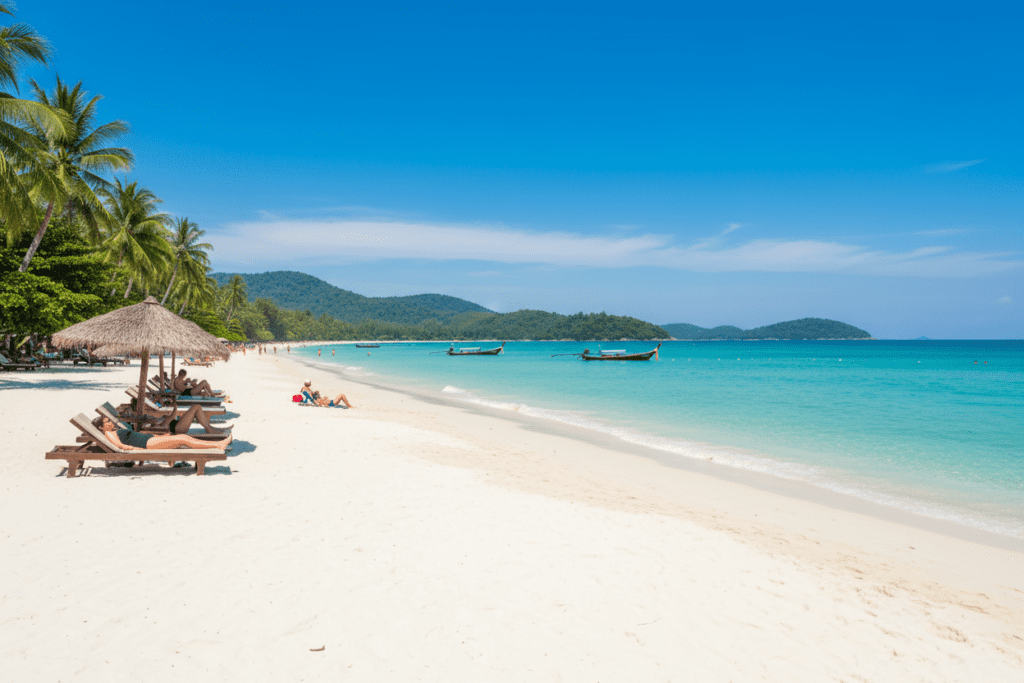
This is it—the sweet spot that most travelers dream about. The best time to visit Phuket weather-wise is hands down from November to early April. This is the island’s dry season, and it’s exactly what you’d imagine when you close your eyes and picture a tropical paradise.
During these months, you can expect endless sunshine, crystal-clear blue skies, and very little rainfall. The weather gods are basically on your side. Temperature-wise, you’re looking at comfortable averages between 24°C to 32°C (75°F to 89°F), with the lowest and most pleasant humidity levels of the entire year.
This weather is absolutely perfect for everything you probably want to do: sunbathing on pristine beaches, swimming in calm seas, island hopping to places like Phi Phi or James Bond Island, scuba diving, and snorkeling. The visibility underwater is incredible during this time.
But here’s the trade-off that catches a lot of people off guard. This perfect weather comes at a pretty significant price. We’re talking about peak tourist season, which means you’ll be dealing with substantially higher prices for hotels, flights, and tours. And those beautiful beaches? They’re going to be packed with other travelers who had the same brilliant idea to visit during the best weather.
With the roads clear and the sun shining, it’s the perfect time to explore Phuket’s stunning coastal roads and hidden viewpoints. Renting a motorbike gives you the freedom to discover these spots at your own pace. For inspiration on the ultimate Phuket road trip, read Discovering Phuket: The Ultimate Road Trip Adventure. Eager to hit the open road? Secure your scooter through Byklo for a seamless rental experience.
Everything You Need to Know for Phuket Dry Season Travel
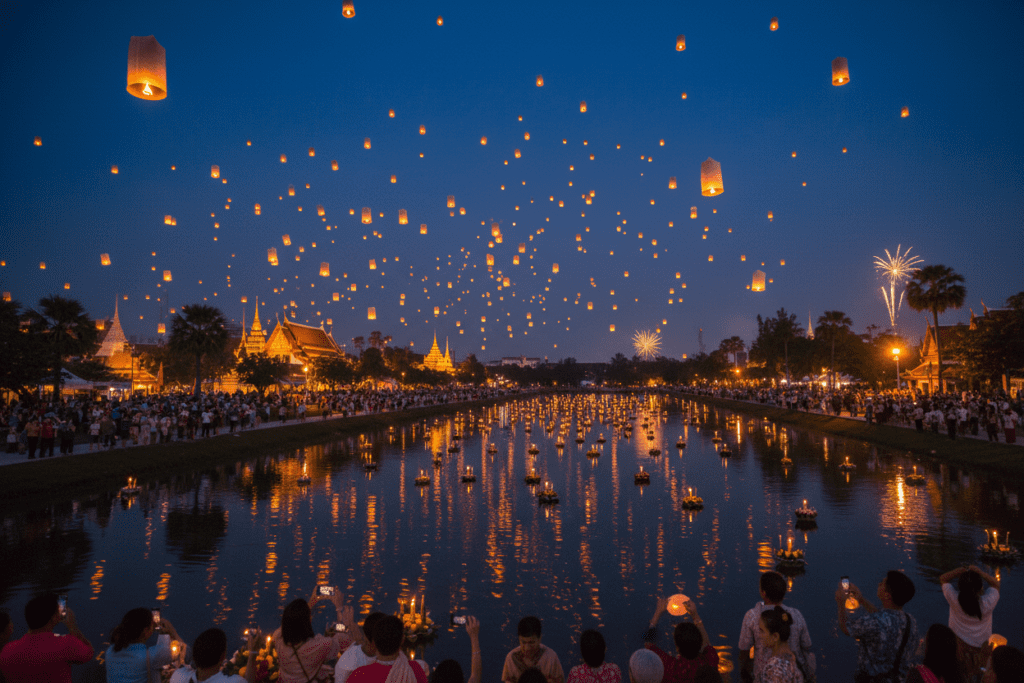
Let’s dive deeper into planning your trip during the dry season, which runs from November to April.
The biggest draw here is the near-guarantee of sunshine for your beach days and outdoor excursions. You can actually plan activities in advance without constantly checking the weather forecast and having backup plans.
This season also coincides with some amazing cultural events. You might catch Loy Krathong (the festival of lights, usually in November) where thousands of lanterns float up into the night sky—it’s absolutely magical. And if you’re there in mid-April, Songkran (Thai New Year water festival) turns the entire island into one massive, joyful water fight.
From a water activities perspective, this is really the only time of year when sea conditions are consistently safe and visibility is excellent for diving and snorkeling. The underwater world around Phuket is stunning, but you need these calm conditions to really appreciate it.
Here’s what you need to know for practical planning: book your flights and accommodations 3-6 months ahead of time. I’m not kidding about this. The best places sell out quickly, especially for Christmas and New Year dates. And prepare yourself mentally for premium pricing—we’re talking high-season rates that can be double or triple what you’d pay during the rainy season.
If you want a bit of a sweet spot, consider November or late March/early April. You’ll still get fantastic weather but with slightly fewer crowds and potentially better deals since you’re hitting the shoulder edges of peak season.
The Traveler’s Guide to the Phuket Rainy Season Months
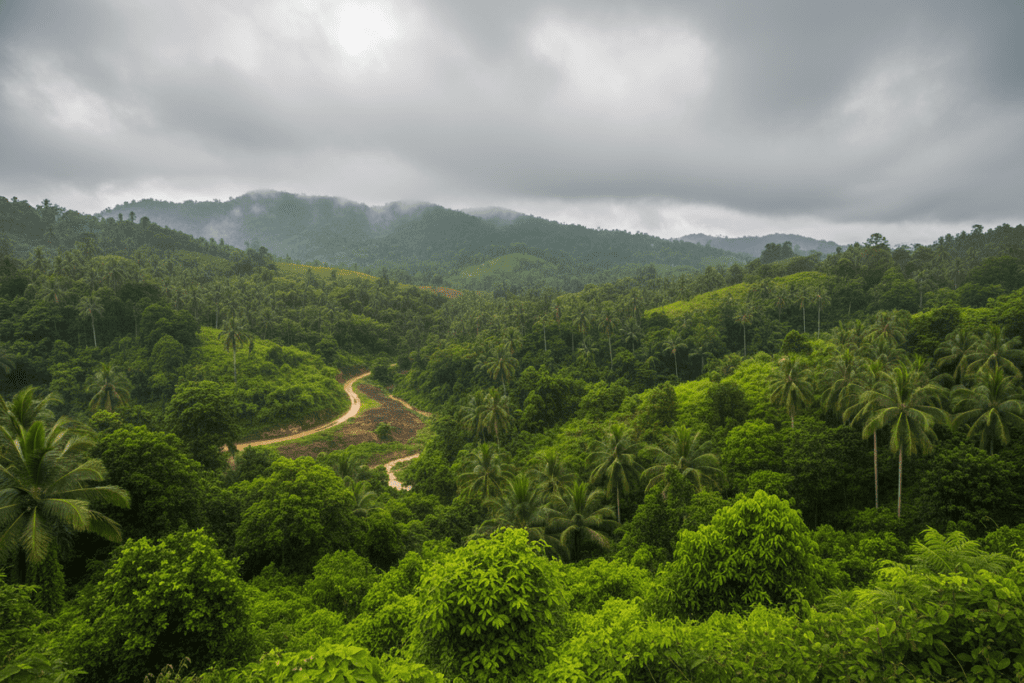
Now let’s talk about the period from May to October, also called the “green season” or monsoon season. And before you completely write this off, hear me out—there are some serious advantages to visiting during the Phuket rainy season months.
First, let me clear up a huge misconception. It doesn’t rain all day, every day. The typical pattern is a heavy, intense downpour in the afternoon for an hour or two, with sunny periods before and after. You might wake up to sunshine, enjoy your morning coffee by the pool, do some exploring, and then retreat to a café or spa when the afternoon rain hits. September and October are definitely the wettest months with the highest chance of prolonged rain, but even then, it’s not constant.
Here are the unexpected advantages that make this season appealing to certain types of travelers: The rain makes the island’s jungles and hills incredibly vibrant and beautiful. Everything is lush and green in a way that’s honestly breathtaking. You’ll enjoy popular beaches and viewpoints with a fraction of the high-season tourists—sometimes it feels like you have entire stretches of coastline to yourself.
But the biggest benefit? Amazing deals. We’re talking significantly lower prices on luxury hotels, flights, and tours. Discover rainy season deals on TwoSeaTour. If you’re a budget traveler or someone who appreciates value, this could be your golden ticket to experiencing Phuket’s high-end side without the high-end prices.
When it does rain, there’s plenty to do indoors: indulge in a spa treatment (Thai massages are incredible), take a Thai cooking class, explore the museums and beautiful Sino-Portuguese architecture in Phuket Old Town, or go shopping at Central Phuket.
Here’s the important warning though: sea conditions can be hazardous during this period. Red flags on the beach mean it is dangerous and forbidden to swim. Don’t mess around with this—people get seriously injured or worse when they ignore these warnings. Ferry and boat trips can be cancelled with little notice, so keep your itinerary flexible.
A Breakdown of Phuket Weather by Month
Let me walk you through what to expect each month so you can make an informed decision about timing.
January – February: This is peak perfection. Dry, sunny days with comfortable evenings that might actually require a light sweater. This is also the busiest and most expensive time of year. If guaranteed sunshine and a lively social atmosphere are your priorities, this is your window. Perfect for all outdoor activities.
March – April: Welcome to the hot season. Temperatures and humidity start climbing, making these the hottest months of the year. It can get pretty intense, especially in April. But there’s Songkran in mid-April, which is essentially a massive, country-wide water fight that’s incredibly fun if you don’t mind getting absolutely soaked. The end of April signals the beginning of the transition to the rainy season.
May – June: The first rains arrive, usually as predictable afternoon showers. This is when the landscape transforms into that brilliant green I mentioned earlier. Tourist crowds thin out noticeably, and accommodation prices start dropping. You can still have plenty of good beach days, just with the occasional afternoon inside.
July – August: Mid-monsoon brings a mix of sunny days and days with heavy but intermittent showers. Waves start getting bigger on the west coast beaches, which can actually be fun to watch even if swimming becomes more challenging. This is when you start finding excellent bargains on hotels that would be completely out of reach during high season.
September – October: These are the wettest months of the year with the highest average rainfall. Expect more frequent rain, higher risk of travel disruptions, and seas that are often too rough for safe swimming. But this is also the quietest and cheapest time on the entire island. Some people love the dramatic storms and the feeling of having Phuket almost to themselves.
November – December: The return of the sun. Rain tapers off quickly in November as the dry season officially begins. The island is incredibly lush from months of rain, creating some of the most beautiful scenery you’ll see all year. There’s a festive atmosphere building into December as tourist numbers and prices start climbing again for Christmas and New Year celebrations.
Identifying the Worst Time to Visit Phuket
Let’s be honest here. For most travelers hoping for a classic beach holiday, the worst time to visit Phuket is September and October.
These months bring heavy and persistent rain that’s different from the shorter afternoon showers you get earlier in the rainy season. Rain can last for longer periods, sometimes days at a time. The seas are often rough with red flags up constantly, making swimming impossible and potentially dangerous. You’ll also face the highest risk of travel disruptions—flooded roads, cancelled boat tours, and generally challenging conditions for getting around the island.
But here’s a counter-perspective worth considering: if your number one priority is the absolute lowest prices and you want to experience Phuket with virtually no other tourists around, this could actually be appealing. You just need to be someone who’s perfectly happy with indoor activities, spa days, cultural exploration, and the dramatic beauty of tropical storms.
Some travelers specifically seek out this time for the intense, moody atmosphere and the feeling of having a tropical island almost entirely to themselves.
Practical Tips for Planning Your Phuket Trip
Let me give you some practical packing advice based on the season.
For the dry season (November-April), pack light: sunscreen (lots of it), a wide-brimmed hat, sunglasses, lightweight beachwear, and comfortable sandals. The sun is intense, so protection is key.
For the rainy season (May-October), add a few key items: a light waterproof jacket, a compact umbrella, insect repellent (bugs are more active during wet periods), and shoes that can get wet and dry quickly.
Regardless of when you visit, build flexibility into your itinerary. Have a solid list of “rainy day” activities even if you’re traveling during the dry season—weather can be unpredictable. Spas, cooking classes, and exploring Phuket Old Town are fantastic all-weather options that many travelers actually end up loving more than beach time.
I strongly recommend purchasing comprehensive travel insurance, especially if you’re traveling during the Phuket rainy season months. This covers potential weather-related cancellations, delays, or changes to your plans.
Phuket is a large island, and renting your own vehicle is honestly the best way to explore freely. Motorbikes are popular and affordable choices for getting around. Before you hit the road, make sure you’re familiar with scooter safety and requirements by checking our Motorbike Rental Thailand Guide: Scooters from 150 THB/Day. And don’t forget to secure your rental through Byklo for peace of mind and reliable service.
When Should You Actually Go?
So when to visit Phuket? It really comes down to what kind of traveler you are and what you value most.
If you’re someone who needs guaranteed sun and socializing, choose the dry season from November to April. You’ll get reliable sunshine, calm seas perfect for water activities, and a lively atmosphere with plenty of other travelers. Just be prepared for higher costs and busier beaches, restaurants, and attractions.
If you’re drawn to savings and serenity, the rainy season from May to October offers incredible deals and a much more peaceful island experience. You’ll have opportunities to see Phuket’s natural beauty at its most dramatic and lush. Just prepare yourself for afternoon showers, rough seas that limit water activities, and the need for more flexible planning.
Both seasons have their magic. The dry season gives you that classic tropical paradise experience, while the rainy season offers a more authentic, less touristy glimpse of island life with the bonus of significant savings.
The key is being honest about your priorities—weather certainty, budget constraints, crowd tolerance, and activity preferences—and choosing the season that aligns perfectly with what you want from your Phuket adventure.
Frequently Asked Questions
What is the best month to visit Phuket?
The best months to visit Phuket are December through February, offering the perfect combination of dry weather, comfortable temperatures, and calm seas. However, this is also peak tourist season with higher prices and crowds.
How bad is the rainy season in Phuket?
The rainy season (May-October) isn’t as bad as many think. Rain typically comes in short, intense afternoon showers rather than all-day downpours. September and October are the wettest months, but you’ll still have plenty of sunny periods throughout the day.
Is it safe to swim in Phuket during rainy season?
Swimming can be dangerous during the rainy season due to rough seas and strong currents. Always check for red flags on beaches, which indicate dangerous swimming conditions. When red flags are up, swimming is prohibited for safety reasons.
When is Phuket least crowded?
Phuket is least crowded during September and October, which are the wettest months. You’ll find significantly fewer tourists, lower prices, and a more peaceful island experience, though you’ll need to be prepared for more frequent rain.
What should I pack for Phuket during different seasons?
For dry season (Nov-Apr): sunscreen, hat, sunglasses, light clothing, and sandals. For rainy season (May-Oct): add a waterproof jacket, umbrella, insect repellent, and quick-dry shoes. Pack light, breathable fabrics year-round due to high humidity.
How far in advance should I book my Phuket trip?
For dry season travel (especially December-February), book 3-6 months in advance to secure the best accommodations and deals. For rainy season trips, you can often find good last-minute deals due to lower demand.
What’s the temperature in Phuket year-round?
Phuket maintains warm temperatures year-round, typically ranging from 24°C to 36°C (75°F to 97°F). Daily highs usually reach 31°C-32°C regardless of season, making it always suitable for beach activities from a temperature perspective.
